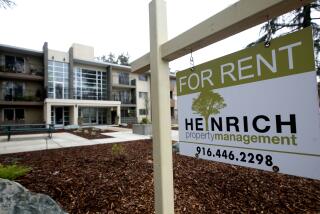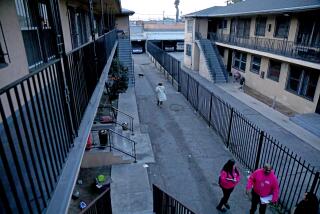Rent Watch: What is ‘normal wear and tear’?
- Share via
Question: I just moved out of a studio apartment that I had been renting for the last year. Now the landlord has informed me that she is keeping $1,000 of my security deposit to pay for refinishing the hardwood floors. I know that my furniture left some marks on the floors, but the landlord told me at one point that the floors were originally installed when the studio was built — about 50 years ago. I don’t think I should be responsible for repairing floors that are so old. What do you think?
Answer: The principles that apply to the disposition of security deposits in California are contained in California Civil Code Section 1950.5. Subsection (b) (2) of this statute says a tenant is responsible for damage to the rental property except for “normal wear and tear.” Your question invokes the wear-and-tear rule, but unfortunately, the statute does not provide any further definition of this rule.
There is an informal formula for calculating normal wear and tear that many housing-related agencies use. Under this formula, you would first determine the useful life of the damaged item. For example, typical carpeting used in rental properties has a useful life of five to seven years. You then calculate how much of the useful life remains. For example, if a five-year carpet was 2 years old when you moved in, and you lived there three years, the useful life would have expired by the time you vacated. In this case, you would not be responsible for replacing the carpet, regardless of its condition.
On the other hand if the carpet was 2 years old, you lived there for one year and the carpet was destroyed at the time you vacated, you would be responsible for 40% of the cost, because the carpet should have been good for two more years — two-fifths, or 40%, of its useful life.
In cases involving the typical flooring found in rental units, the useful life would be far less than 50 years, meaning the wear-and-tear rule would absolve you of any liability for repairs to the floors. However, if the quality and condition of these hardwood floors was exceptional at the time you moved in, you might be responsible for repairs necessary to return them to the same condition.
This type of dispute underlines the advice for both tenants and landlords to document the condition of a rental at both move-in and move-out, particularly where there are unusual features.
Eichner is director of Housing Counseling Programs for Project Sentinel, a Sunnyvale, Calif.-based mediation service. To submit a question, go to https://www.housing.org.
More to Read
Inside the business of entertainment
The Wide Shot brings you news, analysis and insights on everything from streaming wars to production — and what it all means for the future.
You may occasionally receive promotional content from the Los Angeles Times.










